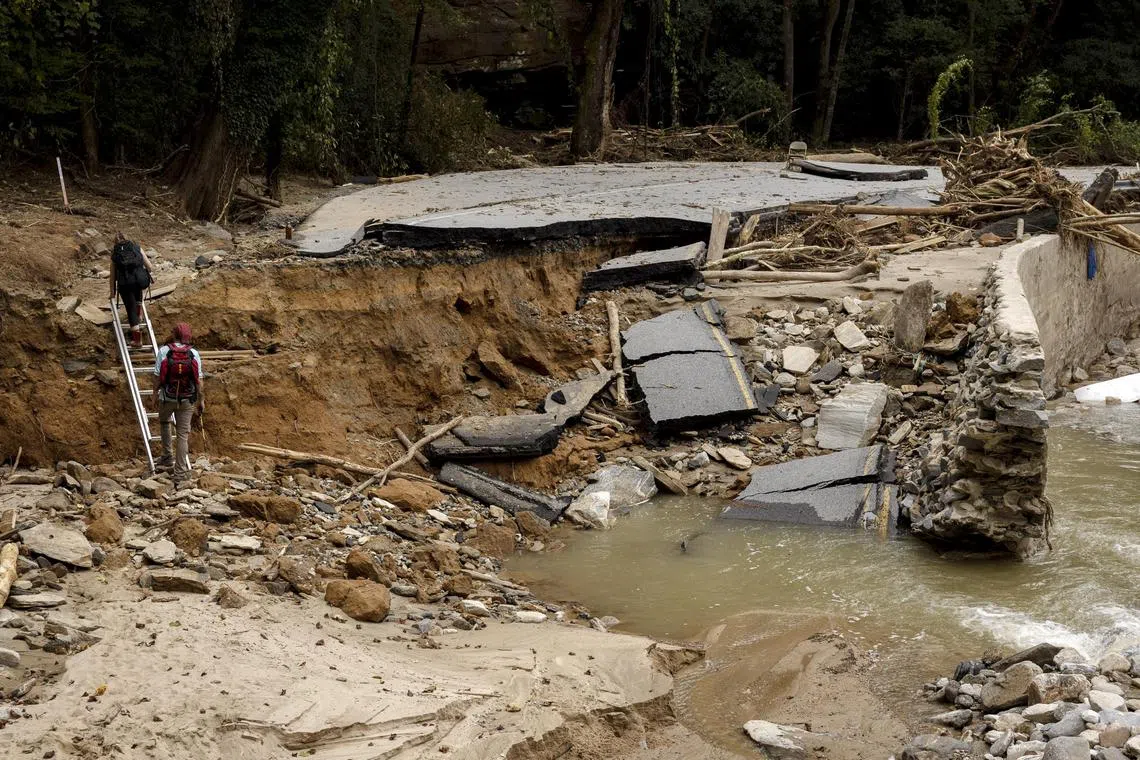After Hurricane Helene’s damage, Appalachian Trail may need years to recover
Sign up now: Get ST's newsletters delivered to your inbox

Hurricane Helene has left large portions of the century-old Appalachian Trail impassable, according to the conservancy that manages it.
PHOTO: NYTIMES
Follow topic:
UNITED STATES – As the scope of devastation caused by Hurricane Helene comes into focus, an American landmark that dozens of towns benefit from is facing historic destruction – the Appalachian Trail.
The 3,540km trail between the states of Georgia and Maine attracts millions of hikers each year, and brings an economic boost to a host of towns along the route.
But in September, Hurricane Helene became the most destructive natural disaster
Damage from flooding, strong winds and tornadoes was present in many of the 14 states the route touches, the Appalachian Trail Conservancy said.
“The scope and scale are historic,” conservancy president Sandi Marra said of the damage. Although it was not yet possible to survey the full extent, she expected it to be widespread.
The conservancy plans to assess the damage and prioritise the hardest-hit areas, but the timeline for clearing and rebuilding the trail will not be quick.
“I cannot imagine it will be normal in 2025,” she said.
Some parts of the trail may need to be rerouted, forcing hikers onto roads. Trailhead parking lots may have been washed away, and small bridges for hikers and highway bridges used to get to the trail may be gone.
The conservancy’s website notes that many of the towns are also encouraging visitors not to come so they can prioritise recovery.
Throughout the region, the hurricane sent water and mud down from mountains. As a result of the deluge, some small towns have been virtually cut off from the outside world.
Some places where hikers stay, eat and form communities can typically expect economic growth and a boost in tourism, the conservancy said.
“Nobody can hike the Appalachian Trail without these communities,” said Mr Gary Sizer, who hiked the trail in 2014 and wrote the book, Where’s The Next Shelter?, about the trip. “The whole experience is a series of three- to five-day backpacking trips. You get to a town, you meet some people. Hikers form a community.”
The conservancy is advising hikers to stay off the trail in some areas. National forests through which the trail passes in North Carolina, Tennessee and south-west Virginia are closed.
Beyond the forests, the conservancy also urged hikers to postpone their trips through a southern stretch between Georgia and Rockfish Gap, Virginia. That is more than 1,287km of the trail.
“People will say they’re not officially closed, and that’s true,” Ms Marra said of the network of trails.
But the storm has made parts of the path “precarious and dangerous”, according to Ms Janet Hensley, who follows and helps hikers from a van every year and is known to many of them as Ms Janet.
“On the trail, you may spend half a day getting through a cluster of trees blocking the path,” Ms Hensley said of the damage.
For any damage to the trail, there is greater concern about the nearby communities. Ms Marra cited Damascus, Virginia; Hot Springs, North Carolina; and Erwin, Tennessee, as among the hardest-hit places near the trail.
Communities in the path of the hurricane, which killed more than 200 people, are still confronting widespread power outages, water shortages and communications failures.
“You have people who are struggling for water and food,” Ms Marra said of the residents around the trail. She suggested hikers travel to places where they would not put pressure on services. “Why strain a system that is already broken?”
For decades, the Appalachian Trail has had a special hold on hikers, with many attempting, and the most intrepid succeeding, in traversing the whole thing.
“It’s a very diverse trail,” Mr Sizer said, explaining its popularity. “In Georgia, it’s lush and humid with rolling hills, somewhat easy-going. North Carolina, that’s your first experience above tree line. By the time you get up north, you’re climbing hand over hand, you’re not just hiking.”
A week before Helene made landfall in Florida, Ms Tara Dower, 31, completed the trail north to south in just 40 days, in what was hailed as a new Appalachian Trail record.
Ordinary hikers, who take five to seven months to hike the full trail, face plenty of challenges even during calmer times.
Mr Sizer said that in the White Mountains of New Hampshire, he had encountered a rainstorm “with winds high enough that I thought someone tackled me. I was on my hands and knees sliding along wet rock from wind alone”.
Still, the trail and surrounding communities are usually a happy and welcoming environment for enthusiasts like Ms Hensley. She has become a well-known sight on the trail for 15 years, driving her sticker-covered van with its large smiley face on the roof to bring water, food and replacement equipment to hikers. During a phone interview, she was interrupted for a selfie.
“When they see the van, it makes them happy,” she said.
But the smiles for hikers and the trail community are muted now. “It’s just heartbreaking,” she said. NYTIMES

